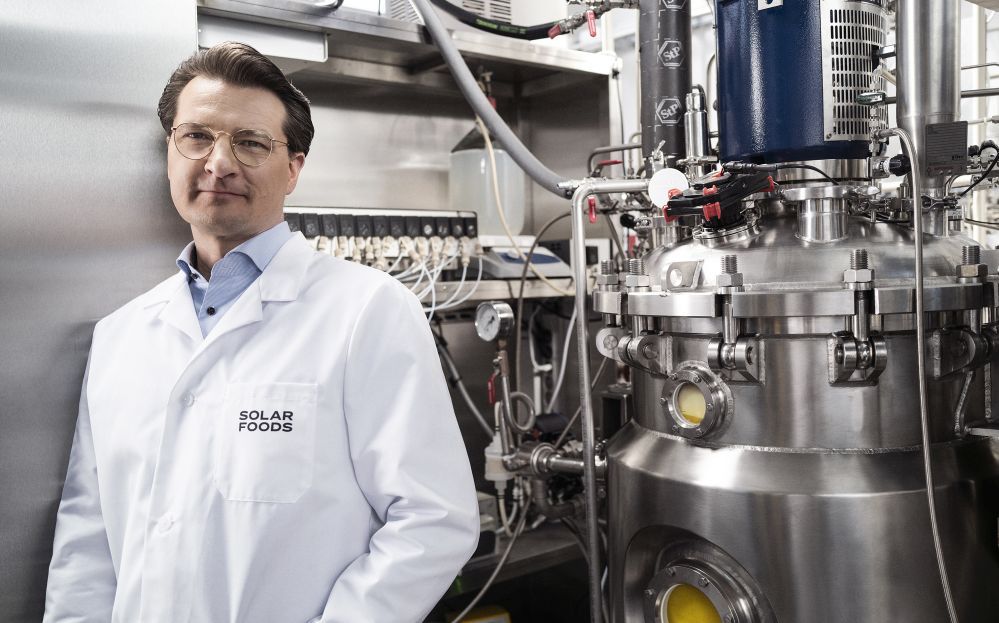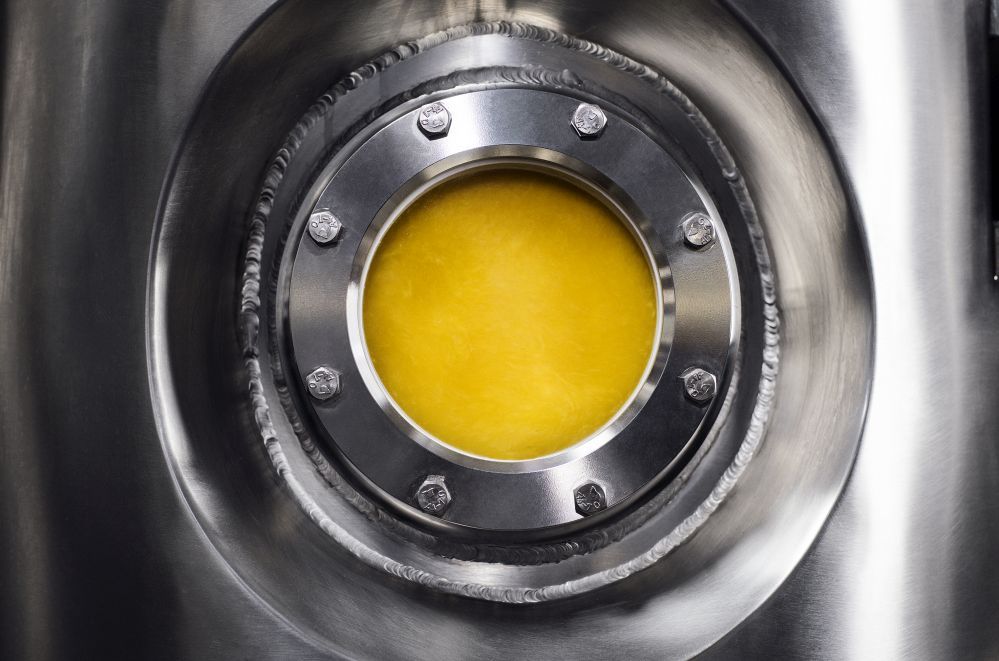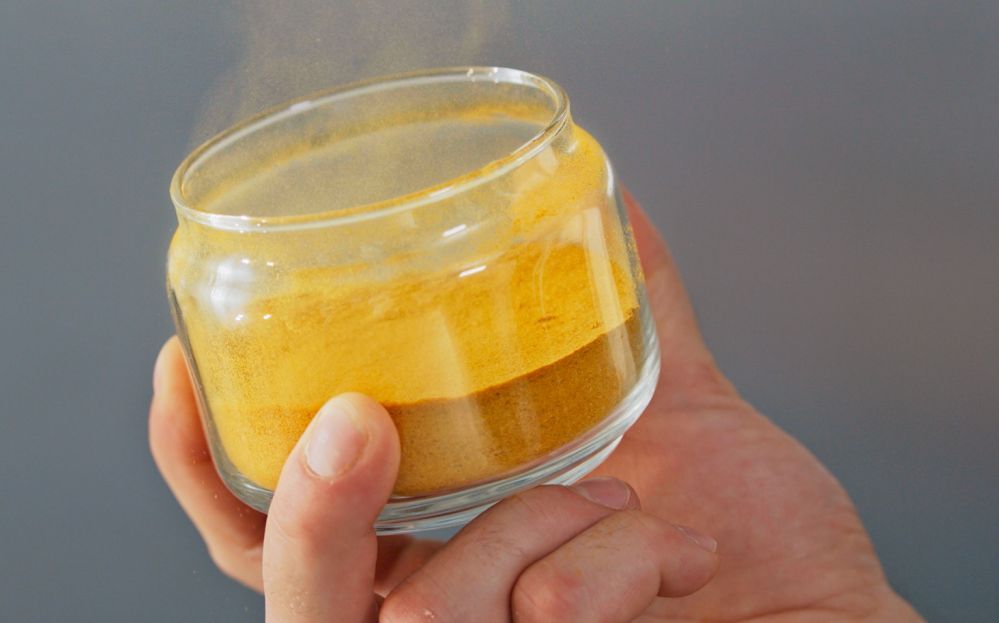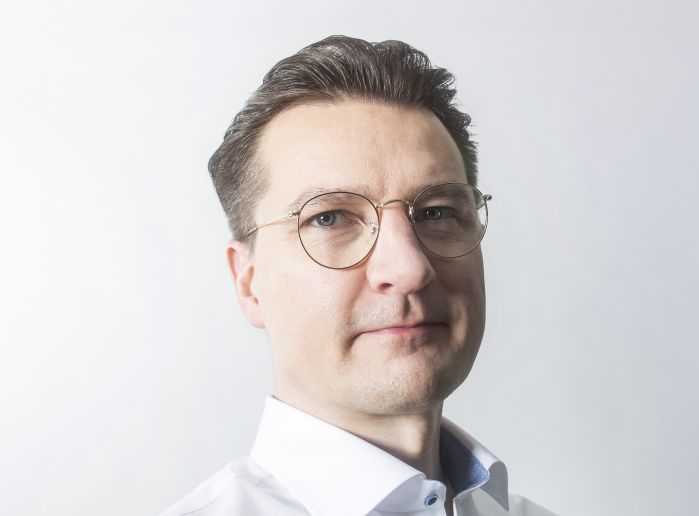One of a small, but high-profile group of startups attempting to decouple food production from agricultural land by feeding microbes elements from the air, Finnish startup Solar Foods, is gearing up to open a new plant to demonstrate its technology at larger scale.
The environmental benefits are clear, assuming the energy-intensive parts of the process are powered by renewables: lower emissions, reduced water and land use, and the ability to locate plants nearer to the end consumer.
But what are the pros and cons of growing food using gas fermentation, and how do you market protein-packed edible bacteria [trade name: Solein] in a way that will resonate with industry partners and consumers in an environment where food and technology are frequently viewed with suspicion?
AgFunderNews (AFN) caught up with Solar Foods’ cofounder and CEO Pasi Vainikka (PV) to discuss the genesis of the business and the highs and lows of running a foodtech company.

AFN: How did Solar Foods come into being?
PV: My background is in energy systems research. In my last job at [the Finnish government-backed technical research center] VTT, I was in charge of the renewable energy research program, which was looking at wind and solar but also making fuels from air, from C02 and hydrogen and so on.
I was then introduced by a colleague to Dr. Juha-Pekka Pitkänen, now our CTO and chief brains officer! He was working in bioprocess engineering, yeast fermentation, methane fermentation, first- and second-generation ethanol, and on organisms that grow directly on electrodes.
So he was also aware that there are organisms that are hydrogen oxidizing because of the early NASA research in the 50s and 60s. For me, it was quite interesting because of the path from electricity to edible calories using bacterial cells as a factory. So we did a proof of concept in late 2017 where we had a teaspoonful of powder of this type of organism [a hydrogen-oxidizing strain of Xanthobacter bacteria] and we started to pitch to investors. We got seed financing in February 2018.
AFN: What bacterial strains are you using, and are you using synthetic biology to engineer them?
PV: They are non-modified, but based on screening of organisms from the Finnish environment. So we identified one that is nutritionally good, non-toxic, fast-growing, but could also grow as a single strain, not as part of a mixed population, which is important for regulatory reasons. We’re also working on a handful of new organisms.
AFN: What are the inputs in your growing system?
PV: Our fermenter is like a big SodaStream. The main feedstocks are carbon dioxide gas, hydrogen gas, some oxygen and then some nitrogen in the growth media, water solution ammonia, and then some nutrients that plants typically take through roots.
We use electrolysis to get the hydrogen [using electricity to split water into its constituent parts, hydrogen and oxygen], which we bubble through our fermenter using pipes. Right now we source liquefied carbon dioxide, which you can get from different industrial sources.
But we also source about 10-20% [of the C02 used in the production process] from a direct air capture device connected to our ventilation system at our headquarters, so when we exhale C02, we use that as a feedstock for our production as well to demonstrate we’re making food out of thin air. But of course there’s a whole direct air capture industry developing, so we are candidate customer for that.

AFN: Given your production process, where does it make sense to locate large-scale plants?
PV: We obviously need to co-locate next to the electrolysis [facility] because transporting hydrogen is like transporting empty tanks! It’s quite cost efficient to transport liquefied C02, but it would also make sense to co-locate next to a C02 source. As for ammonia, so [we envisage that] large factories [run by Solar Foods or third parties] in the future will have ammonia production incorporated in them.
So maybe 5% of the hydrogen that we generate from the on-site electrolyzer would go through synthesis to ammonia, but right now, we buy ammonia from the market. But as with direct air capture for C02, there is also a lot of development happening in renewable hydrogen, so [down the road] we could also be a candidate customer for that too.
AFN: So what’s your current manufacturing set up?
PV: For the last four years we’ve been working from a pilot plant producing about one kilogram per day of the single celled organism, but we’ve invested €40 million ($43 million) into our new demonstration facility near Helsinki that will be able to produce 120 tons per year. This is almost finished and should be coming online in December or January.
The front end of the factory is similar to an oil refinery, the middle part is like a brewery, and the downstream part is like dairy.
AFN: So what is Solein and what’s the appeal to food formulators?
PV: Our ingredient Solein has a mild flavor but a distinct yellow color because of the carotenoids. It is about 68% protein by dry weight, with a good PDCAAS [protein digestibility ] score, not as high as whey but better than most plant proteins. It then has dietary fiber, some lipids, some carotenoids, iron, B12 and so on.
For applications, we are most excited about the non-dairy category, so cheese, ice cream, yogurt, as the texture-forming capabilities are excellent, so it can also replace eggs in mayo applications for example. We’re also proud of the feedback we’re getting from using it to replace egg in some bakery applications, while if you add it to pasta dough, it strengthens it. But there are also applications in meat alternatives and in fortified foods.
If you look at the large food players, they all want to know what’s next after soy that tastes good, is scalable, and has security of supply and consistent pricing, but they also have their ESG goals. I believe we can push all of those buttons. We’re talking about a 10x reduction in carbon footprint compared to plant-based proteins and 100x compared to animal-based generally speaking.
AFN: How will your ingredient be listed on food labels?
PV: We’re quite transparent and open that it’s a bacteria but we don’t know yet how it will be labeled; it will depend on the regulatory authorities. Explaining what we’re doing can be a little complicated for consumers, which is one of the reasons we developed a [b2b brand for the ingredient] Solein, which is a risk, as it’s an investment, but we wanted to keep it short and simple. We hope it will work like Intel inside.
Another reason is that we may license our technology or form joint ventures so that other companies can produce Solein for themselves.
AFN: What’s the go-to-market strategy and how are regulatory applications progressing?
PV: We got approval as a novel food in Singapore last year and Solein was introduced in a gelato there this May. Next year we have also announced that we will launch products with Ajinomoto and we hope to be self-GRAS [Generally Recognized as Safe] in the US by next summer.
In the EU, we have made it through the validation stage [whereby applicants are determined to have met the minimum standard capable of satisfying a safety assessment for novel foods], but it took two years to get to that point. They will now assess our safety, which is a nine-month process, and if they have questions, the clock stops. If there are no questions, we hope to have the EFSA [European Food Safety Authority] opinion by next summer. And after that opinion, there’s the adoption to the European law, so it all takes time.
AFN: Why did it take so long just to get through the initial validation phase?
PV: That’s a million-dollar question. No one explains. It’s a black box. We submitted the dossier in September two years ago number in September? Compared to Singapore, there are no regular meetings for EU novel foods approval, you send out the papers and cross your fingers.
AFN: How do the unit economics of producing Solein compare to other protein sources?
PV: Based on the process we have today, we believe we are already cost competitive against whey, pea, and soy protein isolates if we operate at large commercial scale, which would be thousands or potentially tens of thousands of tons per year.
We want to fundamentally disconnect from land use, from agriculture, that’s the reason why we are here. And when you do that many of the environmental benefits also fall on your lap.
AFN: But aren’t you pretty reliant on electricity for your process?
PV: Electricity is about half of our production costs, mostly for the electrolysis process. So yes, the viability of our process depends on which country you are in and what type of electricity market it has, so you need an efficient electricity market where you operate.
For example, in the Scandinavian electricity market, electricity futures are trading around four cents per kilowatt hour. We know that our production cost are two point something cents, so we’re perfectly happy. But some markets, of course, have higher prices.
So if you look globally, renewable energy sources are the cheapest in inner China, Mongolia, some spots in South America, the Midwest US for wind power, Australia for solar power, northern Scandinavia for wind power and so on.

AFN: How much money have you raised?
PV: Our funding is like a fruit salad with all the different types. So we have raised about €35 million ($37.3 million) in equity, then debt financing and sale and lease back agreements for the demo factory at about €30 million ($32 million) altogether, and then we have grants, including an IPCEI [Important Projects of Common European Interest] grant as we are a clean hydrogen company.
So we have a €34 million ($36.2 million) IPCEI grant at our use for factory 01 [the demo-scale plant near Helsinki] and a further €76 million ($81 million) is earmarked for factory 02 [a large-scale commercial facility] if we were to build on European soil.
AFN: How are investors viewing your technology?
PV: Our largest shareholder is [Finnish food company] Fazer, a 130-year-old family business, but we also have quite extensive material transfer agreements with close to 30 customers, which gives people confidence. But some investors are cautious as there has been a lot of hype [around alternative proteins] and let’s say too many teams working on the same topics.
So we must prove we can compete on price, so investors want to see a techno economic analysis.
I think the broader question in this market is how does this industry scale? The IPO market is closed. The VC market is what it is and even if it was good, they don’t really like [spending money on] concrete and steel. And then the strategics are not really in the game yet big time, so if we think of changing the food system with fermentation, how that will become impactful and how that will unfold during the remainder of this decade is really an interesting question.
But I think there are weak signals that governments are making that will drive this. For example here in the EU, products can’t be imported if they have caused deforestation somewhere else on the planet, which will impact things like soy, coffee and cocoa to start with.
AFN: Can you talk about some of the highs and lows of running a foodtech startup?
PV: The low points are continuous, in the sense that you always have doubts! Early on it was, will the organism be efficient enough so we can meet the price points? Then questions about toxicology and regulatory approval, assessing the value proposition in terms of food applications, the ESG value, and the scaling. So there is this continuous burden of proof… it’s like a marathon rather than a single moment!
But then the high point would be when we were first able to taste products made with Solein, from bread to yogurts. For me, that was magic.




